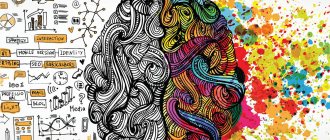Apraxia is a disorder of purposeful voluntary actions and movements, not accompanied by elementary movement disorders, caused by damage to the cerebral cortex.
With apraxia, there is a loss of certain skills (depending on the form of the disease) - motor, speech, professional, everyday; and in children, apraxia is manifested by the inability to learn these skills.
The development of this condition is caused by damage primarily to the parietal lobes of the brain as a result of injury, tumor, stroke, or degenerative processes.
There is no specific treatment for this mental disorder.
Apraxia - what is it?
Apraxia is a pathological condition accompanied by a violation of the ability to perform purposeful sequential movements, provided that the necessary volume of sensory and motor functions is preserved. Apraxia occurs against the background of focal damage to the cerebral cortex and/or subcortical nodes.
The causes of apraxia may be brain tumors, TBI (traumatic brain injury), infections accompanied by damage to the meninges and cerebral cortex, and hemorrhages in the brain.
Praxis - what is it?
Higher nervous activity of a person is called a set of neurophysiological processes that ensure the process of assimilation of information, learning new types of activities, the formation of purposeful behavior, thinking, consciousness and mental activity.
Higher nervous activity (HNA) of a person includes thinking, speech, memory, attention, perception, emotions and temperament, will, imagination, and praxis.
Praxis is the GNI responsible for ensuring the ability to make conscious, purposeful movements. Translated from Greek, praxis is “movement” (accordingly, apraxia is the absence of action, inaction).
Praxis includes:
- learning complex motor acts;
- making purposeful movements;
- automaticity of complex and simple movements.
Regulation of praxis occurs at the level of the cortex and subcortical structures of the brain. When areas of the brain responsible for praxis are damaged, apraxia develops.
For reference. At the same time, apraxia is not accompanied by a violation of muscle tone or pathologies in the motor sphere. The loss of acquired motor skills during apraxia is associated precisely with damage to the structures in the brain responsible for the regulation of praxis.
In most cases, apraxia develops against the background of lesions in the frontoparietal areas of the cerebral cortex.
What does it look like?
Signs of apraxia:
- lack of skills to control facial muscles;
- difficulty getting dressed (problems with tying shoelaces and fastening zippers);
- lack of coordination skills between fingers and hands (problems arise when drawing elementary elements);
- difficulties in relating the use of objects and the type of activity where they should be used;
- walking disturbances;
- a person cannot step over or go around an obstacle;
- previously absent stoop is noted.
Causes of apraxia
Apraxia can develop due to:
- brain tumors (most often, the development of apraxia is caused by gliomas, astrocytomas , ganglioneuroblastomas, which tend to gradually grow into the cortex and subcortical centers, and the gradual destruction of zones involved in ensuring praxis);
- cerebrospinal fluid and dermoid cysts, aneurysms and arteriovenous malformations, leading to compression and death of cortical neurons, as well as to the disconnection of connections between associative fields in the cortex and subcortical structures of the brain;
- neurodegenerative diseases accompanied by diffuse damage to the cortex and basal ganglia due to Alzheimer's disease, dementia, Pick's disease , alcoholic encephalopathies, corticobasal degenerations, complications of diabetes, Parkinson's disease;
- strokes (the cause of apraxia can be both ischemic (arising as a result of spasm of the cerebral arteries, thromboembolism) strokes, and hemorrhagic strokes associated with rupture of the wall of a cerebral vessel);
- traumatic brain injuries (apraxia can develop both as a result of direct damage to the areas of the cortex responsible for praxis, and against the background of secondary damage to these areas due to post-traumatic hematoma, edema, ischemic processes, inflammation);
- infectious damage to the brain and/or its membranes with encephalitis, meningoencephalitis , brain abscesses;
- autoimmune diseases accompanied by diffuse damage to the gray and white matter of the brain;
- various severe intoxications (alcohol, drugs, poisoning with drugs, pesticides).
For reference. Risk factors for the development of apraxia are considered to be age over sixty years, the presence of a hereditary predisposition, severe hypertension, diabetes mellitus, cardiovascular diseases, chronic alcoholism, and a history of strokes.
Types of apraxia
Apraxia is divided according to the localization of the pathological process in the tissues of the brain and according to the types of cognitive impairment that have developed.
Depending on the location of the pathological focus, the following types of apraxia are distinguished:
- frontal (develop against the background of damage to the cortex of the anterior part of the frontal lobe (prefrontal cortex), the main symptoms of frontal apraxia are: loss or impairment of the ability to make complex and sequential movements);
- motor (motor apraxia is manifested by maintaining the ability to plan one’s further actions, but losing the ability to perform these actions);
- premotor (develops against the background of damage to the premotor area of the cortex and the 6th CPB (Brodmann's cytoarchitectonic area), manifested by loss of automaticity of actions, as well as loss of skills required to transform simple actions into complex ones);
- cortical (develop against the background of damage to the cortex in the dominant hemisphere of the brain);
- bilateral (bilateral forms of apraxia, developing with damage to the inferior parietal lobe).
Symptoms of apraxia
The symptoms of apraxia depend primarily on the type of apraxia and its severity.
What is common to all types of apraxia is that the patient has a movement disorder while fully maintaining the required volume of sensorimotor functions.
For reference. Patients with apraxia are not characterized by the presence of paresis, sensory disturbances, paralysis, muscle tone disorders, ligamentous injuries, or joint contractures. That is, the limbs of a patient with apraxia are completely “suitable” for performing the required range of movements.
More detailed symptoms of some types of apraxia are as follows.
Lipmann's kinetic apraxia
For reference. Kinetic (ideomotor) Lipman apraxia most often develops against the background of progressive Alzheimer's disease (against the background of degenerative damage to the secondary sensory and somatotopic analyzers of the cortex).
If the cortex of the dominant hemisphere is affected (the left hemisphere for right-handers and the right for left-handers), bilateral apraxia is observed.
The main symptoms of Lipmann's apraxia are:
- the patient getting “stuck” at a certain stage of the motor act,
- lack of smooth transition between movements,
- clear delineation of movements,
- impaired coordination of movements and fine motor skills.
Patients have impaired ability to maintain the required posture, impaired writing, the ability to hold objects, fasten and unbutton buttons, and sew.
The patient also loses the ability to understand symbolic movements (winks, blowing a kiss).
Patients with kinetic apraxia are unable to demonstrate an action with an object without picking it up (symbolically showing how to eat soup or drink from a cup).
In this case, the patient retains the ability to plan an action, but he cannot perform it. In some cases, with a strong concentration of attention and constant visual control of the action being performed, the patient can carry out the intended movement.
Spatial apraxia
For reference. Spatial types of apraxia are accompanied by a violation of orientation in space and direction (right-left, top-bottom).
Such patients are unable to dress themselves or assemble any object consisting of several parts. Individuals with spatial apraxia also have impaired ability to write letters and numbers.
Forecast
The outlook for people with apraxia will depend on individual circumstances. If a person has apraxia after suffering a stroke or other neurological disorder, treating the underlying condition will help reduce or eliminate the symptoms of apraxia. Some people's apraxia symptoms will improve over time, while others may experience less improvement. Some people continue to improve for several years or even decades. With the right support from loved ones, people with apraxia can learn to manage their condition.
Related article: What are speech disorders?
Diagnosis of apraxia
For reference. Diagnosing apraxia is quite difficult. It is necessary to exclude other possible causes of movement disorders (associated with impaired muscle tone, limited mobility in the joint).
The evaluation of a patient with suspected apraxia should include:
- examination by a neurologist;
- conducting neuropsychological tests (the patient is asked to perform certain actions, manipulate imaginary and real objects, and check the automaticity of movements);
- neuroimaging of the brain using CT, MRI, MSCT.
Differential diagnostics with pyramidal insufficiency, sensory ataxia, cerebellar disorders, and agnosia are also performed.
Symptoms
The clinical picture is specific, but in some cases it goes unnoticed or does not cause pronounced discomfort. Often the problem is discovered during a special neurological examination.
Kinetic apraxia (like other varieties) can have the following external manifestations:
- difficulty in reproducing sequential manipulations;
- difficulties in performing movements requiring spatial orientation;
- stiffness of motor operations;
- walking in small steps;
- difficulty getting dressed;
- slurred speech;
- inability to control the movements of the tongue and lips;
- violation of temporal and spatial orientation;
- problems opening or closing your eyes;
- the impossibility of long-term visual fixation on one object;
- stable reproduction of individual elements of a motor operation.
In addition to specific symptoms, ideomotor apraxia (similar to other varieties) is expressed by the following anomalies:
- irritability;
- emotional instability;
- aggression;
- tendency to depression.
At the first sign of a disorder in a child or adult, you should consult a neurologist as soon as possible.
Treatment of apraxia
For reference. Treatment consists of correcting the underlying disease that led to the development of apraxia (Pick's disease, Alzheimer's, Parkinson's disease, stroke, brain abscess).
Drug therapy for apraxia includes the following:
- drugs that improve cerebral hemodynamics (vasodilators, thrombolytics, drugs that improve microcirculation can be used);
- neuroprotectors;
- nootropic drugs;
- etiotropic drugs aimed at eliminating the underlying disease.
After elimination or correction of the underlying disease, restorative therapy is prescribed (neuroprotectors and nootropics, physical therapy, massage, physiotherapy).
If necessary, neurosurgical intervention is performed.
Preventive measures
Pathology can be prevented only by general recommendations. In medicine, there are no specially developed measures to prevent this pathology. You can reduce the risk of disease if:
- Completely give up bad habits.
- Spend a lot of time outdoors and exercise regularly.
- Maintain proper diet.
- Massage your feet and hands at home.
- Monitor blood pressure.
- Do not leave even minor head injuries untreated.
- Get medical examinations regularly.
Apraxia is a disease that does not pose a threat to the patient’s life. But in the absence of the necessary treatment, complications may develop in the form of the inability to care for oneself independently, the development of disability, and disruption of adaptation both in social and labor terms. It is important not to ignore the symptoms of the disease and undergo the necessary course of treatment.











